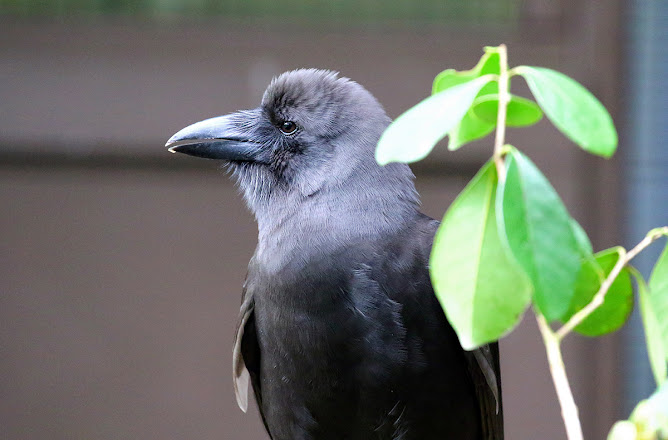 |
| ʻAlalā could be introduced into the Kaʻū Forest Reserve in the future, according to The ʻAlalā Project. Photo from The ʻAlalā Project |
 |
| A pair of ʻAlalā. Photo by Mamo Waianuhea |
"It is hoped that releases could be planned for the Kaʻū Forest Reserve after more management for promoting native forest habitat has occurred," says a statement from the ʻAlalā Project. Kaʻū Forest Reserve was established in 1906 to protect forest on lower slopes of Mauna Loa in Ka'ū District.
From 2018 to 2019, ʻAlalā release efforts took place in the Pu'u Maka'ala Natural Area in Puna. "Pu'u Maka'ala Natural Area Reserve has been managed for many years to promote native forests, is fenced and free of ungulates (cows, pigs, sheep, etc.), has a dense understory, and lots of ʻAlalā food plants," according to The 'Alalā Project.
 |
| Kaʻū Forest Reserve could be a future release site for endangered ʻAlalā, the Hawaiian crow. Map from Dept. Land & Natural Resources |
Project goals are: " To establish a wild self-sustaining population of ʻAlalā; that wild ʻAlalā will fulfill their ecological roles in the native forest ecosystem; and the population will need little help from humans to survive."
The latest newsletter from The ʻAlalā Project notes that the organization is often asked how to "tell a male ʻalalā from a female ʻalalā by looking at them. It is very hard to tell them apart just by their appearance. Male ʻalalā are usually slightly larger and heavier than the females but often you cannot tell this apart just by looking at the birds. In order to determine the birdsʻ sexes at the conservation breeding center a simple blood test is done which looks at the bird's genetics. Each bird is given a color band combination to help keep track of the individual and to identify each bird."
In other news, The ʻAlalā Project was represented Jan. 1 in the 133rd Rose Bowl Parade in Pasadena. The float was sponsored by San Diego Zoo Wildlife Alliance to highlight conservation work around the world with its partners. See a video on the float at https://twitter.com/sandiegozoo/status/1477394503363
 |
| San Diego Zoo Wildlife Alliance's float in the Rose Bowl parade, honoring The ʻAlalā Project and many other conservation efforts by the organization and its partner around the world. Photo from SDZWA |
To read comments, add your own, and like this story, see www.facebook.com/kaucalendar/. See latest print edition at kaucalendar.com.
FOR ITS NEWS YEAR'S RESOLUTION, STATE OF HAWAI'I SHOULD GO ON A BUDGETARY DIET, says Keli'i Akina of Grassroot Institute of Hawai'i. The founder and President of the organization issued the following:
The first day of a new year is traditionally a time for resolutions and self-improvement. So, in that spirit of personal growth, it's time we engage in some brutal candor about a problem in our state that's difficult to ignore. Yes, Hawaii's state budget needs to go on a diet. I admit, the past two years have been tough for all of us. Who hasn't put on a few pounds since March 2020, when most of us were ordered to hang around the house more — where our refrigerators are located — in an effort to stop the spread of COVID-19? But Hawai'i's state budget had been packing on the pounds long before the coronavirus lockdowns started; its current ballooning figure is the result of years of indulgence and bad habits.
If anything, 2021 was a wake-up call. Some state policymakers actually started to consider eating a few fresh vegetables, which in this case means spending cuts. But then state tax revenues came in higher than expected, the federal bailout added more money to the coffers, and most of them went right back to snacking on high-calorie tax dollars, avoiding balanced budgeting as if it were an actual treadmill.
In releasing his executive supplemental budget for fiscal 2023, Gov. David Ige announced that Hawai'i's rebounding economy has resulted in "astounding" tax revenues. As a result, I am happy to say, he says he is not planning any tax increases.
But the Legislature is a wild card, and I am pretty sure some of its members have different plans. The truth is, however, that the best way to increase state revenues is not through tax hikes, but through policies that grow the economy. The state can reap far more through economic growth than it can through an increase in taxes, as the first five months of fiscal 2023 just proved.
During the 2021 legislative session, too many of our lawmakers refused to see this and simply went ahead and increased our taxes, further burdening Hawai'i's businesses and taxpayers.
The panic over the possible loss in revenues caused by the lockdowns was so severe that the Legislature took away the county shares of the state transient accommodations tax, leaving the counties to levy their own TATs, which all have done.
Combined with the state's general excise tax of 4%, plus the 0.5% county GET surcharges on Kaua'i, O'ahu and Hawai'i island, which tourists also pay, the Aloha State now has the highest tourist taxes in the nation, topping out at 17.75% — not exactly ideal to help Hawaii's ailing tourism industry recover.
But back to the bloated budget: At present, the state is looking at a budget windfall, thanks to higher tax revenues and an infusion of federal aid funds. But rather than revert to its usual bad habits, the state should resolve for 2022 to slim down and achieve good health. As any fitness guru will tell you, the first step toward improvement is to stop the bad habits.
No more saddling future generations with high debt. Don't postpone paying down unfunded liabilities. Don't borrow more for new projects. Post a reminder on the refrigerator to not raise taxes on Hawai'i residents or businesses. Even better, look for ways to cut taxes and lower the cost of living, perhaps by working more with the private sector to deliver certain public services. As I said, the best way to produce tax revenues is through economic growth.
Sure, it won't be easy; significant self-improvement is usually a major challenge. But we're not looking to put the state budget on a crash diet.
We want state policymakers to embrace a lifestyle change for 2022, one that will lead to a healthier, happier and more prosperous Hawai'i for generations to come.
The first day of a new year is traditionally a time for resolutions and self-improvement. So, in that spirit of personal growth, it's time we engage in some brutal candor about a problem in our state that's difficult to ignore. Yes, Hawaii's state budget needs to go on a diet. I admit, the past two years have been tough for all of us. Who hasn't put on a few pounds since March 2020, when most of us were ordered to hang around the house more — where our refrigerators are located — in an effort to stop the spread of COVID-19? But Hawai'i's state budget had been packing on the pounds long before the coronavirus lockdowns started; its current ballooning figure is the result of years of indulgence and bad habits.
If anything, 2021 was a wake-up call. Some state policymakers actually started to consider eating a few fresh vegetables, which in this case means spending cuts. But then state tax revenues came in higher than expected, the federal bailout added more money to the coffers, and most of them went right back to snacking on high-calorie tax dollars, avoiding balanced budgeting as if it were an actual treadmill.
In releasing his executive supplemental budget for fiscal 2023, Gov. David Ige announced that Hawai'i's rebounding economy has resulted in "astounding" tax revenues. As a result, I am happy to say, he says he is not planning any tax increases.
But the Legislature is a wild card, and I am pretty sure some of its members have different plans. The truth is, however, that the best way to increase state revenues is not through tax hikes, but through policies that grow the economy. The state can reap far more through economic growth than it can through an increase in taxes, as the first five months of fiscal 2023 just proved.
During the 2021 legislative session, too many of our lawmakers refused to see this and simply went ahead and increased our taxes, further burdening Hawai'i's businesses and taxpayers.
The panic over the possible loss in revenues caused by the lockdowns was so severe that the Legislature took away the county shares of the state transient accommodations tax, leaving the counties to levy their own TATs, which all have done.
Combined with the state's general excise tax of 4%, plus the 0.5% county GET surcharges on Kaua'i, O'ahu and Hawai'i island, which tourists also pay, the Aloha State now has the highest tourist taxes in the nation, topping out at 17.75% — not exactly ideal to help Hawaii's ailing tourism industry recover.
But back to the bloated budget: At present, the state is looking at a budget windfall, thanks to higher tax revenues and an infusion of federal aid funds. But rather than revert to its usual bad habits, the state should resolve for 2022 to slim down and achieve good health. As any fitness guru will tell you, the first step toward improvement is to stop the bad habits.
No more saddling future generations with high debt. Don't postpone paying down unfunded liabilities. Don't borrow more for new projects. Post a reminder on the refrigerator to not raise taxes on Hawai'i residents or businesses. Even better, look for ways to cut taxes and lower the cost of living, perhaps by working more with the private sector to deliver certain public services. As I said, the best way to produce tax revenues is through economic growth.
Sure, it won't be easy; significant self-improvement is usually a major challenge. But we're not looking to put the state budget on a crash diet.
We want state policymakers to embrace a lifestyle change for 2022, one that will lead to a healthier, happier and more prosperous Hawai'i for generations to come.
To read comments, add your own, and like this story, see www.facebook.com/kaucalendar/. See latest print edition at kaucalendar.com.
COUNTY OF HAWAI'I CIVIL DEFENSE ISSUED ANOTHER COVID ALERT on New Year's Day: "For Hawai'i County the Department of Health reports 195 new cases with 1284 active cases and nine persons hospitalized. As we celebrate the 2022 New Year the entire State and Island of Hawaii is experiencing high rates of Coronavirus transmissions and community spread. Know that when you leave your residence you may be exposing yourself to Coronavirus.
"Be reminded that the mandate requiring wearing of face coverings indoors continues along with gatherings of no more than 10 persons indoors and 100 persons out of doors. Distancing oneself from others outside your family group and staying home when you are sick are necessary to stop the spread.
"The Department of Health recommends getting vaccinated and getting a booster shot to protect yourself, your family, and friends."
For a comprehensive calendar and list of all pharmacies and clinics providing vaccination and testing, please visit the Civil Defense website. Civil Defense: www.hawaiicounty.gov.
"The Department of Health recommends getting vaccinated and getting a booster shot to protect yourself, your family, and friends."
For a comprehensive calendar and list of all pharmacies and clinics providing vaccination and testing, please visit the Civil Defense website. Civil Defense: www.hawaiicounty.gov.
To read comments, add your own, and like this story, see www.facebook.com/kaucalendar/. See latest print edition at kaucalendar.com.



















